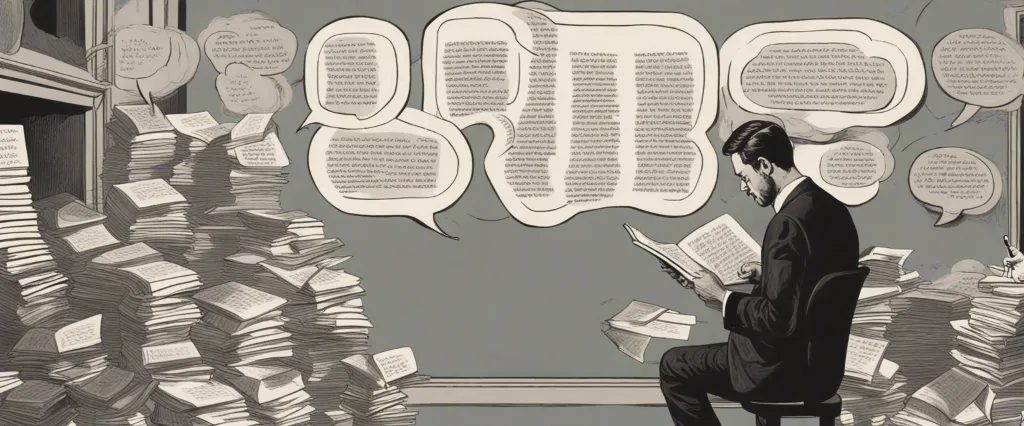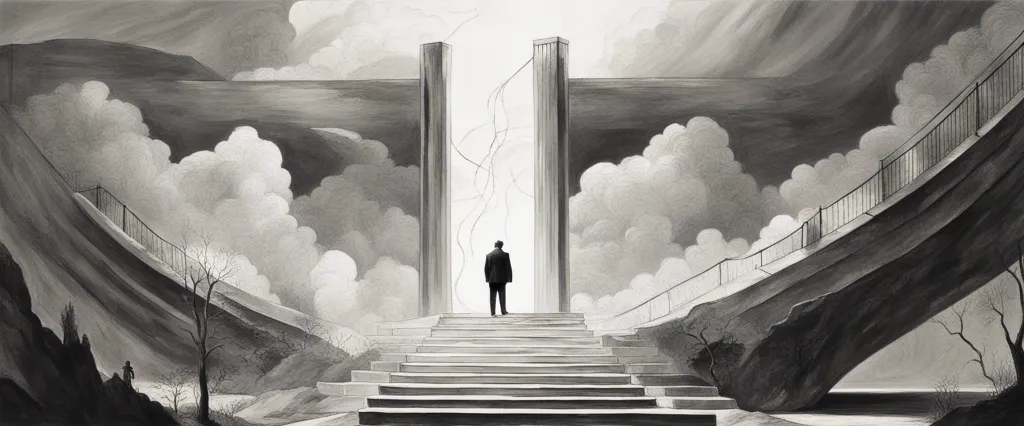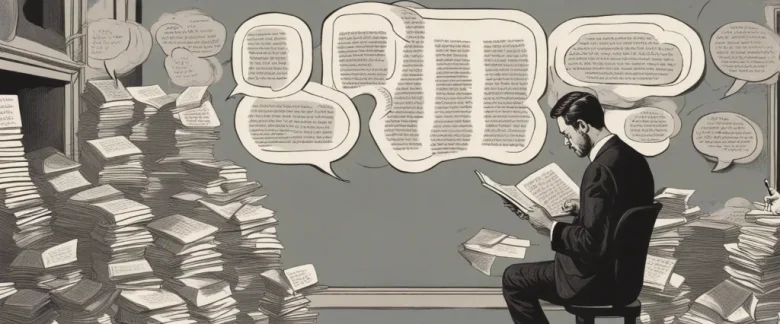
In “How The Mighty Fall,” renowned author and management expert James C. Collins delves into the process of decline that befalls once great companies. Drawing upon years of research, Collins unveils a set of five stages that organizations typically pass through on their path to downfall. Through compelling case studies and insightful analysis, he provides invaluable lessons on how companies can recognize and navigate these stages to avoid their demise. Collins, widely recognized for his groundbreaking works such as “Good to Great” and “Built to Last,” has established himself as a leading authority on management and organizational performance. His research and writings have revolutionized the way leaders think about business success and failure, making him one of the most influential thinkers of our time.
Chapter 1: Hubris Born of Success
In Chapter 1 of “How The Mighty Fall” by James C. Collins, the author introduces the concept of hubris born of success and explores the first stage of decline that companies often experience. Collins highlights that it is not external factors alone that cause the downfall of great companies, but rather their own overconfidence and arrogance as a result of past success.
Collins argues that success can breed a sense of invincibility, causing organizations to become complacent and resistant to change. Leaders start ignoring warning signs and fail to adapt to new challenges, as they believe that their past achievements will secure their future. However, this hubris can set the stage for their eventual downfall.
The chapter further examines the symptoms of hubris and how it leads to decline. Organizations often start to exhibit arrogance, becoming insulated from external feedback and limiting dissenting voices within their ranks. They start making risky decisions, ignoring potential pitfalls and believing they are immune to failure. As a result, they lose sight of their original core values and become disconnected from their customers and market realities.
To exemplify his argument, Collins uses real-world case studies, such as IBM and Procter & Gamble, to demonstrate how hubris can blind even the most successful organizations. These companies, once revered and dominant, fell into decline due to their own hubris, ultimately leading to financial difficulties and reputational damage.
In conclusion, Chapter 1 of “How The Mighty Fall” emphasizes that pride and complacency are the initial stages of decline for successful companies. Building on its premise, the book aims to explore the stages of decline further and provide insights into how organizations can identify and counteract this hubris to prevent their own downfall.
Chapter 2: Undisciplined Pursuit of More
Chapter 2 of “How the Mighty Fall” by James C. Collins is titled “Undisciplined Pursuit of More.” The chapter explores one of the factors that contribute to the downfall of once-great companies: the undisciplined pursuit of growth without considering the risks and consequences.
Collins illustrates this undisciplined pursuit of more through the story of the Bethlehem Steel Corporation. Bethlehem Steel was once a dominant force in the steel industry, but its downfall began when it shifted focus from their core business in search of new growth opportunities. The company was driven by an insatiable appetite for more, expanding its operations into various industries, such as real estate, coal mining, and shipbuilding. However, these ventures were not strategically aligned with their core expertise.
The undisciplined pursuit of more led Bethlehem Steel to overextend its resources and weaken its competitive advantage. The company’s leadership failed to recognize the risks and challenges associated with diversification outside their core business. Financial resources were stretched thin, and management attention was divided, resulting in a decline in performance across all areas of the company.
Collins highlights the dangers of pursuing growth without discipline and a clear understanding of the underlying risks. He emphasizes that exceptional companies maintain a clear focus on their core competencies and strategically expand within their established areas of expertise. The discipline lies in saying no to opportunities that may lead to distraction or dilution of resources.
Ultimately, the undisciplined pursuit of more can erode a company’s competitive advantage and pave the way for its downfall. By learning from the mistakes of Bethlehem Steel, leaders can avoid the trap of reckless expansion and ensure their organizations remain on the path to long-term success.
Chapter 3: Denial of Risk and Peril
Chapter 3 of “How the Mighty Fall” by James C. Collins explores the concept of denial of risk and peril and its impact on the downfall of once successful organizations. Collins suggests that denial is often the first stage in the decline of a company, where leaders fail to acknowledge the risks and potential threats they face.
The chapter begins by highlighting the importance of being vigilant and attuned to warning signs. Collins emphasizes that leaders must maintain a realistic view of their organization’s position and be willing to confront and address any potential risks or dangers. However, he observes that denial often sets in due to complacency, arrogance, or a belief in past successes.
Collins identifies four stages of denial: denial of risk, denial of peril, denial of urgency, and denial of consequences. Denial of risk refers to leaders disregarding or underestimating potential threats to their organization’s stability and growth. Denial of peril occurs when leaders downplay the severity of a crisis or fail to recognize the seriousness of their situation. Denial of urgency is the inability to mobilize and take decisive actions when needed. Lastly, denial of consequences is the failure to accept responsibility for the outcomes resulting from risks and perils.
Throughout the chapter, Collins provides real-life examples of companies which experienced denial of risk and peril, leading to their downfall. He stresses that denial is a conscious choice, and organizations must actively combat it to avoid ruin. To prevent denial, leaders must embrace a mindset of disciplined thought, create a culture of truth-telling within the organization, seek out diverse perspectives, and commit to a constant, objective assessment of risks and potential threats.
In summary, Chapter 3 of “How the Mighty Fall” illustrates the destructive consequences of denial of risk and peril in organizations. Collins warns leaders about the dangers of complacency and emphasizes the need for constant vigilance and a realistic evaluation of potential risks. Only by acknowledging and addressing these risks can leaders avoid the downward spiral that denial brings.
Chapter 4: Grasping for Salvation

Chapter 4 of “How the Mighty Fall” by James C. Collins, titled “Grasping for Salvation,” explores the second stage of decline in companies or organizations. Collins identifies this stage as the tipping point after hubris and the beginning of a downfall.
Collins emphasizes the significance of recognizing this stage, as it offers a critical opportunity for leaders to take action and reverse the trajectory of their organization’s decline. The chapter focuses on several key factors that characterize this stage.
Firstly, Collins discusses the rise of denial, where leaders refuse to acknowledge the gravity of the situation. Companies experiencing decline often exhibit complacency, believing that their past successes will provide a safety net. This denial prevents leaders from appropriately responding to the worsening conditions.
Secondly, there is a call to external saviors as leaders desperately seek new ideas, technologies, or acquisitions to save their organization. However, Collins warns against relying solely on such external factors, as a true recovery must come from within. Collaboration between internal and external contributors is crucial to aligning expertise and resources effectively.
Thirdly, Collins highlights the temptation of bold but potentially risky strategic initiatives. Leaders in decline may push for grandiose plans in an attempt to regain lost ground quickly. However, such initiatives should be approached with caution, as they can cause further damage if not adequately executed.
The chapter concludes with an emphasis on the importance of humility and discipline during this stage. Leaders should focus on making tough decisions, confronting brutal facts, and executing a disciplined strategy. Collins emphasizes that recognizing the “Grasping for Salvation” stage is vital to initiating the process of recovery and avoiding the final stages of decline.
Chapter 5: Capitulation to Irrelevance or Death
Chapter 5: Capitulation to Irrelevance or Death, from the book “How The Mighty Fall” by James C. Collins, delves into the fourth stage of decline that organizations often face. This stage represents a downward spiral that ends with the demise of once-great and influential companies.
Collins explores how companies at this stage tend to lose their sense of purpose and direction. They become complacent and fail to adapt to changing markets, technologies, or customer needs. This stage is characterized by a lack of innovation, resistance to change, and a focus on short-term gains at the expense of long-term sustainability.
One of the key factors contributing to this decline is what Collins terms “undisciplined pursuit of more.” Companies in this stage frequently overreach their capabilities and make irrational decisions, such as ill-advised mergers or acquisitions. They also become overwhelmed by bureaucracy, losing agility and the ability to respond effectively to external challenges.
Another aspect of this stage is the loss of accountability. Leaders often distance themselves from failures and refuse to take responsibility for poor decisions. This lack of ownership further erodes the organization’s ability to learn from mistakes and adapt.
In this chapter, Collins emphasizes the importance of humility and discipline to prevent or reverse this stage of decline. He highlights the need for leaders to confront the brutal realities and make tough decisions, even if it means significant short-term pain. He also stresses the significance of maintaining a clear and resilient core ideology that guides the organization through challenging times.
Ultimately, Chapter 5 alerts readers to the dangers of complacency and a failure to evolve, showing how these factors can lead to the eventual demise of once-great companies.
Chapter 6: The Road to Recovery
Chapter 6: The Road to Recovery of James C. Collins’ book “How The Mighty Fall” provides insights into the strategies and actions necessary for organizations to recover from their decline and restore their former greatness.
Collins emphasizes that in order to begin the journey towards recovery, leaders must first confront the reality of their situation. They need to acknowledge the mistakes made, accept responsibility for the decline, and refuse to make excuses or point fingers. This self-reflective process is crucial because it enables leaders to recognize their own shortcomings and initiate change.
Next, organizations embarking on the road to recovery must commit to a culture of discipline. This entails setting clear priorities, establishing a focused and well-aligned team, and adhering to the principles of consistency and consistency of action. Leaders must instill a sense of ownership and personal responsibility throughout the organization, ensuring that every individual is aligned towards the same objectives.
Another vital aspect is the concept of Using Adversity to Lead. This involves transforming setbacks and challenges into opportunities for growth. Leaders should encourage their teams to learn from failures, seek feedback, and adapt their strategies accordingly. By leveraging adversity, organizations can build resilience and develop the ability to thrive in a rapidly changing environment.
Lastly, Collins emphasizes the importance of staying true to one’s core values. Organizations must define and preserve their guiding principles, ensuring that they remain the foundation of their actions. Leaders should resist the temptation to compromise or abandon these principles in the face of pressure or short-term gains, as it jeopardizes the long-term recovery and sustainability of the organization.
In summary, Chapter 6 outlines the road to recovery for declining organizations. It emphasizes the need to confront reality, embrace discipline, leverage adversity, and stay true to core values. By implementing these strategies, organizations can begin the journey towards regaining their former greatness.
Chapter 7: Good to Great and the Flywheel Effect
Chapter 7 of “How The Mighty Fall” by James C. Collins focuses on the concept of the Flywheel Effect and its relationship with the journey from being a good company to becoming a great one. The author uses the analogy of a flywheel to emphasize the slow and continuous build-up of momentum required for sustained success.
The Flywheel Effect suggests that in order to transform a company from good to great, it is essential to build momentum over time. Collins explains that this momentum is achieved by a series of incremental actions, each of which contributes to the overall progress of the company. These actions are not isolated events but rather a constant and relentless push towards greatness.
The chapter highlights several key characteristics that enable the Flywheel Effect to take place. First, it emphasizes the importance of disciplined people who display consistency and persistence to drive the company forward. Second, companies that embrace empirical creativity are more likely to make incremental improvements and discover what works best. Third, such companies exhibit a commitment to fact-based decision-making, gathering data and challenging assumptions. Lastly, companies that align their actions with a clear understanding of their core purpose and principle outperform those that lack a defined direction.
Collins also warns against the dangers of complacency and the temptation to make big, sudden changes or take shortcuts. Instead, he promotes the idea that by consistently pushing the flywheel and making incremental improvements, a company steadily gains momentum and gradually transitions from being good to becoming truly great.
Overall, Chapter 7 highlights the importance of the Flywheel Effect and how it contributes to the journey from good to great. It provides valuable insights into the mindset and actions required for sustainable success in organizations.

Chapter 8: Building a Culture of Discipline
Chapter 8: Building a Culture of Discipline of the book How The Mighty Fall by James C. Collins delves into the importance of discipline within organizations and how it can contribute to their success or failure. Collins emphasizes that discipline should not be confused with rigid bureaucracy or control; rather, it is about creating an environment where individuals take ownership and are accountable for their actions.
The chapter starts by highlighting how companies that have fallen from greatness often lack discipline. They become complacent and lose focus, resulting in a decline in performance. However, Collins also explains that discipline alone is not enough to ensure success. It must be combined with creativity and entrepreneurship to foster a culture that encourages innovation and growth.
Collins introduces the Flywheel concept, which symbolizes the momentum and leverage created by a combination of discipline and consistent effort. He urges organizations to create mechanisms that reinforce discipline, such as a compelling vision, core values, and clearly defined success metrics. These mechanisms align individuals and teams toward a common goal and promote accountability.
The author also stresses the significance of self-discipline, encouraging leaders to model it and surround themselves with disciplined people. Building a culture of discipline requires recruiting and retaining individuals who embrace the company’s values and hold themselves to high standards. Collins suggests a rigorous hiring process to ensure the right fit and consistently evaluating employees against the company’s core values.
The chapter concludes by emphasizing the need for discipline in decision-making. Leaders should prioritize long-term success over short-term gains and make difficult decisions when necessary. A culture of discipline fosters an environment where employees become self-governing and take ownership of their work, ultimately leading to sustainable success and preventing the downfall of the organization.
After Reading
In “How The Mighty Fall” by James C. Collins, the author explores the reasons behind the downfall of once-great companies and offers insights on how to prevent such a fate. Through an in-depth analysis of various case studies, Collins identifies five stages of decline that companies typically go through, from hubris born of success to eventual collapse. He emphasizes the importance of humility, discipline, and adaptability in sustaining long-term success. By examining the causes and warning signs of organizational decline, Collins provides readers with valuable lessons on how to avoid complacency and continuously evolve in an ever-changing business landscape. Overall, “How The Mighty Fall” serves as a cautionary tale and a guide for both leaders and organizations to not only survive but thrive in the face of adversity.
1. The Alchemist” by Paulo Coelho – This philosophical novel follows the journey of a young Andalusian shepherd named Santiago as he seeks his Personal Legend. With its rich symbolism and inspiring narrative, this book explores themes of destiny, self-discovery, and the importance of listening to one’s heart.
2. “To Kill a Mockingbird” by Harper Lee – Set in the 1930s, this classic novel delves into the lives of Scout and Jem Finch, siblings growing up in a racially divided Alabama town. Through their father’s determined fight for justice and themes of racial inequality, morality, and compassion, Lee tackles timeless issues with grace and poignancy.
3. The Great Gatsby” by F. Scott Fitzgerald – Set in the Roaring Twenties, this iconic novel tells the story of Jay Gatsby, a mysterious millionaire, through the eyes of narrator Nick Carraway. Fitzgerald explores themes of the American Dream, wealth, love, and disillusionment in this beautifully written tale that captures the essence of an era.
4. The Power of Now” by Eckhart Tolle – In this transformative book, Tolle dives into the concept of mindfulness and the importance of living in the present moment. By guiding readers through practical advice and spiritual insights, he invites them to let go of past regrets and future worries, offering a pathway to inner peace and fulfillment.
5. “The Kite Runner” by Khaled Hosseini – This powerful novel set in Afghanistan follows the story of Amir, a young boy from Kabul, and his complicated relationship with his childhood friend Hassan. Through themes of loyalty, redemption, and the devastating consequences of betrayal, Hosseini weaves a gripping tale that explores the complexities of guilt and the pursuit of redemption.



